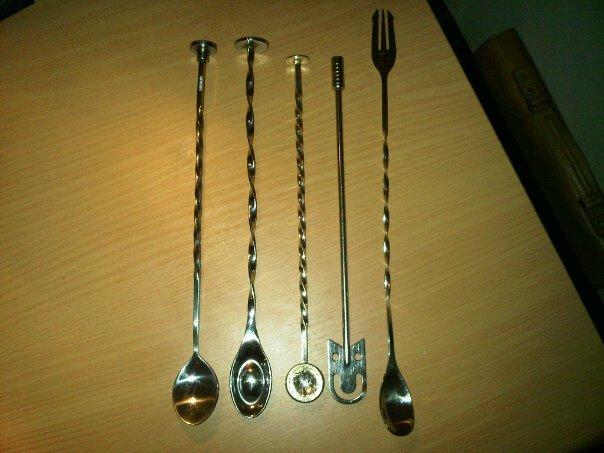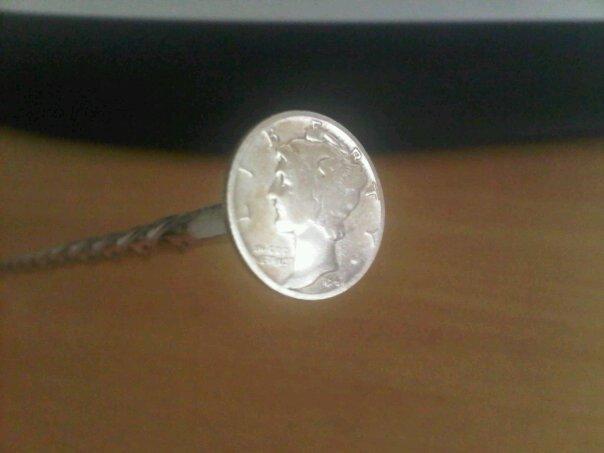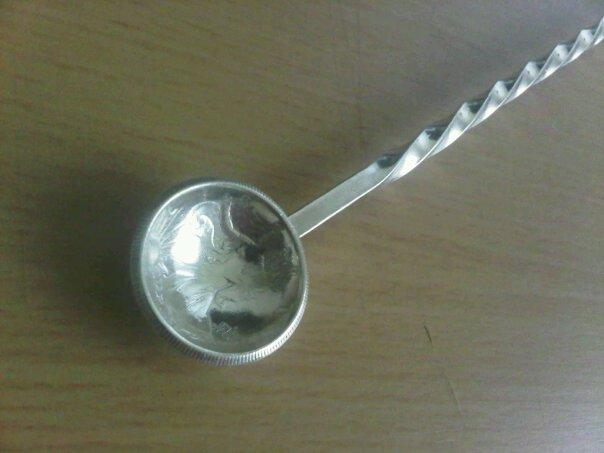-
Posts
437 -
Joined
-
Last visited
-
I wrote this piece which may give you some insight - http://thejerrythomasproject.blogspot.co.uk/2011/05/bottle-and-barrel-aged-cocktails-new.html However, Pimm's was probably one of the first bottled cocktails* when it started being produced to provide a consistent product following the success of James Pimm's Fruit Cup. *Am I the only one who doesn't like using that term when speaking about a time when cocktails were a specific rather than an all-encapsulating term?
-
Glad to hear it. Ot of curiousity what ratio/ingredients did you use? If you get the chance visit the recipe archive on my bitters webpage (see my signature below) for a host of vintage and original Boker's recipes, as well as drinks calling for the rest of my line.
-
I didn't know these guys existed until I looked them up just now. Judging by the botanical listing for their recipe they haven't done any research into the Boker's company and/or the original bottling. They've got things in there that weren't in the original. They also make some strange claims regarding Khoosh Bitters ("a British proprietary tonic that was used in saloons along the Cocktail Route of San Francisco in the 1890s") considering they were never imported into the United States. We know of only two bottles of Khoosh in the World, and I have one of them, so I'm pretty sure they've never obtained a sample and/or the info required to produce a faithful reproduction.
-
Pic of the aforementioned spoons and Alessi stirring rod. The one in the middle was made by Defaced barware (sadly no longer in existence) and is a thing of beauty with both the spoon and disc ends being old American coins. There's very few around...
-
Wanted to add to this topic, like many bartenders I've collected a number of spoons over the years and will take a picture of them all when I get the chance. Only pic I have just now is of five of them. I also purchased this today from Golden Age Bartending; I've asked Pablo (who runs the site) about a third attachment for hand-cracking ice, or to make the muddler end heavier, and he's going to look into it for me. It may be weighty enough but I'll find out when it arrives in a few days.
-
Well after 1927 when the Boulevardier first showed. Seems both the Boulevardier and Old Pal originated in Paris (unless there is something in that 1878 reference and it's not a joke of sorts)... I've been speaking to Dave on email this afternoon I mentioned that in post 137. I think it unlikely it would have been created in Edinburgh but to address this query there was a culture of mixed drinks in and around various parts of Scotland. From what I know it was doubtful to include the likes of Campari though. I forwarded the above to Wondrich;
-
I got that, I was responding to the spelling. Anyways, the 1922 Old Pal recipe pre-dates this mention and specifies dry vermouth. Whether there's something older that contradicts this, and goes back closer to 1878 (as alluded to in Barflies & Cocktails) has yet to ascertained however let's say for argument's sake it did (and I'm beginning to think there may be something in this) it would make sense the Old Pal first called for sweet vermouth and later evolved to dry vermouth similar to drinks such as the Martini and Martinez. Some key dates worth considering to fit the pieces together; 1878 - Old Pal alleged to have been created by Sparrow Robertson at the Old Powderhall Foot Races (see 1927) 1887 - New York Herald in Paris founded on 4th October 1890 - Harry MacElhone born in Dundee, Scotland 1911 - Harry MacElhone opens Harry's New York Bar in Paris 1921 - William Harrison "Sparrow" Robertson joins the NY Herald in Paris 1922 - Oldest known recorded recipe for the Old Pal found in Harry's ABC of Mixing Cocktails along with this line, "The drink was created by "Sparrow" Robertson, the Sporting Editor of the New York Herald in Paris." 1923 - MacElhone takes over ownership of Harry's New York Bar 1927 - Barflies & Cocktails attributes the drink to the same "Sparrow" Robertson with the following description, "I remember way back in 1878, on the 30th of February to be exact, when the Writer was discussing this subject with my old pal "Sparrow" Robertson and he said to yours truly, "get away with that stuff, my old pal, here's the drink I invented when I fired the pistol the first time at the old Powderhall foot races and you can't go wrong if you put a bet down on 1/3 Canadian Club, 1/3 Eyetalian vermouth, and 1/3 Campari." and then he told the Writer that he would dedicate this cocktail to me and call it, My Old Pal." Anything and everything I've found relating to a Powderhall foot race which dates back to 1870 (now known as the New Year Sprint) relates to a yearly event held in Edinburgh. Taking into account that Campari hadn't made the US in 1878, that this Sparrow chap seems to have been fairly prevalent when it comes to athletics, and given his stature in the sport, would it be right to assume Sparrow a guest at the 1878 race in Edinburgh and that's where it was created? Or was there a similarly named race elsewhere. Must look into this... I also found this line interesting - "Everyone from Hemingway to The Prince of Wales was "My Old Pal" to Sparrow."
-
No problem. The full quote is extremely interesting (and something I have been looking into) as it suggests to me the Old Pal dates back to 1878 and pre-dates the Negroni by quite some time?!? Haha. At a guess, and judging by the tone of the appendix, the spelling is a humorous stab at his pronunciation of Italian. It certainly makes sense as there are too many recipes calling for either Canadian or bourbon for them to have been very close in taste/flavour.
-
Again I'd say it's not just the vermouth, it's both*. The various Old Pal recipes from around that period call for Canadian Whiskey or Rye (with dry vermouth), and the Boulevardier is/was Bourbon (with sweet vermouth). Like other drinks I'd fully expect their to have been some form of evolution or change across different books but every one I own or have access to detail these specifics (with these same ratios). Possibly a bigger difference between Canadian and bourbon at that time?
-
First known references to the Boulevardier and the Old Pal are in this article I wrote about the Negroni and its variants; Old Pal first shows in 1922 (Harry’s ABC of Cocktails) and calls for Canadian whiskey. The Savoy later specifies Canadian Club, The Official Mixer's Manual specifies rye. Boulevardier first shows in 1927 (Barflies and Cocktails) and calls for bourbon. The Old Pal is found in the appendix also calling for Canadian whiskey, and from the above blog;
-
Personally think it's not solely the spirit or the vermouth, it's both. An Old Pal is a specific cocktail calling for rye and dry, as is the Boulevardier with bourbon and sweet. I'm still looking for Negroni variants so may turn up a name for an Old Pal with sweet vermouth, or a Boulevardier with dry, but nothing as yet.
-
Sorry. Next time I'll Assume. Create fictional story. Try to appear clever. I'll bear that in mind. Anyway, this has deviated away from talk of the Negroni and its variants. Reading through Sulle Tracce Del Conte (Luca Picchi's book on the Negroni) he has a number of variants at the back with both the Cardinal and Cardinale being listed; ...when I was researching the variants I kept stumbling across these two different spellings though it was uncommon to find a difference between the two. The book would suggest that the difference is simply the ratio though I will have to dig a little deeper to ascertain if this is the case.
-
You really didn't need to say anything else after that. However... I didn't just cite a recipe as evidence, I added a link to an article I recently wrote which provides strong evidence that the Martinez and Martini were one and the same. It also covers the evolution of the Martini into the drier variant more common today. ...but you're assumption has led to you somehow deciphering that I believe someone asking for a Martini in this day and age means they are asking for a drink which more closely resembles the Martinez as we know it, or the Martini as it was made in the late 1800s. Yup. You've cleared that up indeed.
-
How exactly have you assumed all that? Did you actually read what I posted? The point was about selling the Martinez. Which, as most people make it today, is almost identical to the Martini as it was first known (see picture I posted above). And the reason we're talking about that is because I jokingly pointed out to eje that there's little difference between a Manhattan, Martinez and Martini (in the historical sense, hence the link and picture), after he'd said he's more likely to drink the former two over the latter. Obviously aware of the fact he was speaking of the Dry Martini. In the last decade I can only think of one guest who has ordered a Sweet Martini, and I'm 100% confident they were unaware of the Martini as it was in 1888, more likely they wanted a fashionable drink served sweeter as they don't like the more recognisable dry variant. Thinking about it, there's a very good chance I hadn't made a Martinez in a bar, like many other bars and bartenders, until my Boker's reformulation in 2009. Particularly so as it was around this time that Old Tom also became readily available again. My thoughts on that are here for anyone that is interested.
-
I have. You know that Boker's thing I did? And that cocktail the Martinez? Sold quite a few of them. "You say poh-tay-toe, I say poh-tah-toh, you say Martini, I say Martinez."





